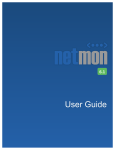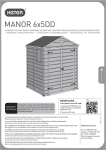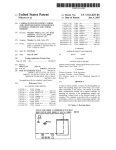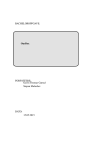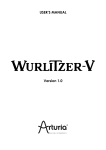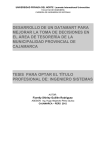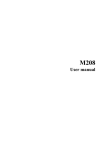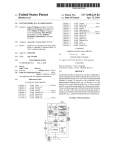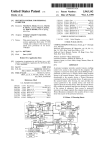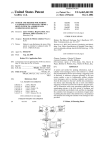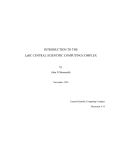Download lllllllllllllllllllllllllllllllllllllllllllllllllllllllllllllllIIIIIIIHIII
Transcript
lllllllllllllllllllllllllllllllllllllllllllllllllllllllllllllllIIIIIIIHIII USOO5359648A United States Patent [191 [11] Patent Number: 5,359,648 Dunn et al. [45] Date of Patent: Oct. 25, 1994 [54] ESCAPE SEQUENCE USING MONITORING OF CONTROL SIGNAL STATES FOREIGN PATENT DOCUMENTS 0457704 11/1991 [75] Inventors: Tave P. Dunn; Elie A. Jreij, both of Austin, Tex.; Richard M. Ludwin, OTHER PUBLICATIONS ROLMphone User’s Manual; pp. 114 to 11-10. Poughkeepsie, NY; William ELevene, Austin, Tex. [73] Assignee: European Pat. Off. .............. .. 375/8 _ _ . Primary Exammer—Curt1s Kuntz Assistant Examiner—lason Chan Rolm Company, Santa Clara, Calif. [21] Appl. No.: 997,995 [57] [22] Filed: A method and apparatus for escaping from transparent mode in which the Data Communication Equipment Dec. 28, 1992 5 [51] [52] ABSTRACT will escape from transparent mode (into command Int. Cl. ..................... .. H04M 11/00; H04L 5/16 US. Cl. ...................................... .. 379/93; 379/94; mode) if a user programmed escape character string is received in coincidence with the toggling of a control _ 375/8 [58] Field of Search ..................... .. 379/93, 94, 96, 99, 379/98; 375/84 9’ 121’ 104’ 114 [56] R f re Cit d signal such as Request To Send (RTS). Advanta geously’ this escape method can be used in conjunction with time/data escape methods that are based soley on activity on the received data line. When the two meth e e nces e ods are used together, a supervisor program or control U.S. PATENT DOCUMENTS 4,549,302 10/1985 Heatherington ...................... .. 375/8 4,926,448 5/ 1990 Kraul et a1. ................... .. 375/121 4,928,305 5/ 1990 Yui ........................................ .. 375/8 device can force an escape notwithstanding the user Programmed time constraint Parameters in the DCC 17 Claims, 4 Drawing Sheets 102 109 f 105 0 1038 PROCESSOR g -4 v T PROGRAM 5 cm 6 1301 1 M R R S APPLICATION K FDATA 1 1 0 I132 E50. SEO. PROGRAM 107 f T114 1; 120 DATA TRANSFER WORKING AREA C DATA BUFFEHS 1 f 104 ,124 125 comm) PROC. 108 \ X PROCESSOR H T 122 s H ‘S P a 112 T 2 116 305 /304 ABC OEFG HIJ KLMN 131/ PROGRAM DATA com. / Z TELEPHONY / CONTROL PROC. ’ no f TELEPHONY / AU 105 ,_ SUPERVISOR PRUCESSUR l r305 XXX A12 A101 5551212 KEYBUAHD 134 US. Patent Oct. 25, 1994 Sheet 2 of 4 FIG. 2 TURN OFF RERUEST TU_ SEND (RTS) / l THANSMIT ESCAPE SEQUENCE DATA / 202 204 L 206 TURN 0N / REUUEST TU SEND FIG. 3 306 /3o4 ABC DEFG HIJ KLMN l /308 ‘ xxx‘ ATZ ATUT 5551212 :302 FI G. 6 305 /304 ABC DEFG HLJ KLMN _ l xxx fsoa ATZ ATDT 5551212 602 5,359,648 US. Patent Oct. 25, 1994 Sheet 3 of 4 FIG. 4 RESET ESCAPE CHARACTER COUNTER ESCAPE CODE CHARACTER? INCREMENT ESCAPE CHARACTER COUNTER 418 ESCAPE FROM TRANSPARENT MODE 5,359,648 1 5,359,648 2 to cause an escape) the characters in the escape se ESCAPE SEQUENCE USING MONITORING OF CONTROL SIGNAL STATES BACKGROUND OF THE INVENTION quence must arrive separated from one another in time by less than a predetermined time. 5 A. Field of the Invention This invention relates to data communication equip an embodiment of the present invention the Data Com ment. munication equipment (DCE) will escape from trans parent mode if the escape character sequence (the es cape code) is received in coincidence with the toggling of a control signal such as Request To Send (RTS). Advantageously, this escape method can be used in B. Related Art Apparatus which perform data communication oper ations over telephony lines are well known in the art. For example, it is known to provide a digital telephone with a data communication controller (DCC) which ' enables an attached computer to communicate with the conjunction with purely data based escape methods, digital telephone itself, or with another device (e. g. another computer) by way of a digital telephony line. such that a supervisor program or control device can force an escape notwithstanding user programmed time Where data communication over an analog telephony line is desired, a modulator-demodulator (more com monly known as a “modem”) is used to convert the constraint parameters in the DCE. BRIEF DESCRIPTION OF THE DRAWINGS digital computer generated signals into modulated ana log signals for transmission over the analog telephony FIG. 1 is a functional block diagram of a data com munication device according to an embodiment of the lines. A modem at a receiving station demodulates the present invention; analog signals and converts them back into digital form for use by a digital device at the receiving end of the telephony line. DCCs and modems typically have two modes of operation: a “transparent mode” in which digital data from the sending device is passed through to the tele phony lines (in analog form in the case of a modem), and a “command mode” in which the DCC or modern will accept commands from the sending device. For exam ple, while in command mode the sending device may have the DCC dial a number or select an incoming or outgoing line on the digital telephone. The prior art includes a number of ways of switching between transparent mode and command mode. For example, it is known in the art to have a modem switch from transparent mode to command mode upon recog nition of a prede?ned escape sequence. The escape SUMMARY OF THE INVENTION The present invention comprises a method and appa ratus for escaping from transparent mode. According to 25 FIG. 2 is a flow chart of the operation of Data Termi nal Equipment according to an embodiment of the pres ent invention; FIG. 3 is a timing diagram of the operation of the data communication device of FIG. 1; FIG. 4 is a ?ow chart of the operation of Data Com munication Equipment of FIG. 1; and FIG. 5 is a logic diagram of an alternative embodi ment of the present invention; FIG. 6 is a timing diagram of an alternative escape sequence to that of FIG. 3. Like reference numerals appearing in more that one ?gure depict like elements. DETAIL DESCRIPTION OF THE PREFERRED EMBODIMENTS sequence may take a number of forms. For example, the 40 Turning ?rst to FIG. 1, a DCC of a type suitable for escape sequence may take the form a non-printable use with a digital telephone is illustrated. A suitable character, such as “Ctrl-X” (the “X” key depressed along with the “Ctrl” key). One problem with such escape sequences is that, digital telephone is described, for example, in copend ing application Ser. No. 07/936,963; ?led Aug. 28, 1992, which is incorporated by reference herein. The DCC while in transparent mode, if a sequence of characters 45 includes two microprocessors 102, 104, each of which matching the escape sequence happens to appear in the includes an internal Universal Asynchronous Recei transmitted character stream, the DCC or modem may ver/Transmitter (UART). The primary microprocessor undesirably or unexpectedly change from the transpar ent mode to the command mode. Thus, in DCCs or modems where it is desired to transmit the escape se quence characters across the link while in transparent mode, special provision is made to distinguish a recep tion (from the computer) of the escape character se quence which is intended to be retransmitted as data, from reception of the same escape character sequence which is intended as a signal for the DCC or modem to switch from transparent mode to command mode. The prior art includes a number of mechanisms for delimiting the “true” escape sequence from a sequence of characters to be retransmitted. For example, in syn 102 (eg a Motorola 68302) is connected to the internal data bus 103 of a conventional digital telephone (not shown), the secondary microprocessor 104, a set of RS-232 transceivers 106, a random access memory (RAM) 108 and a read only memory (ROM) 110. The secondary microprocessor 104 (e.g. a Motorola 6805) is connected to the primary microprocessor 102, the control bus 105 of the conventional digital tele phone and a second set of transceivers 112. The trans ceivers 106, 112 are, in turn, respectively connected to a ?rst RS-232 port (PORTI) 114 and a second RS-232 port (PORT2) 116. The secondary microprocessor 104 chronous protocols it is known to precede the escape sequence by prede?ned delimiter characters. For asyn chronous transmissions, it is known in the art to provide serves as a conduit between the primary microprocessor a modem with a mechanism that escapes from transpar nal code to pass ISDN call status events (received from 102, and the control bus 105 and second RS-232 port 116. The secondary microprocessor 104 includes inter ent mode, if and only if the escape sequence is preceded 65 the network via the control bus 105) to the primary microprocessor 102 and to pass commands and re and/or followed by a predetermined time period during which no characters are transmitted. Some escape sponses between the second RS-232 port 116 and the mechanisms add the additional constraint that (in order primary microprocessor 102. 3 5,359,648 4 microprocessor and includes a data buffer area for the RS-232 ports. The ROM 110 includes a number of pro includes data lines 107 (which carry transmitted and received data) and control lines 109 (which carry the RS-232 control signals, such as Data Terminal Ready, grams (subroutines or processes) which are executed by Data Set Ready, Clear To Send, and Request To Send). the primary microprocessor 102. These processes in The escape sequence of the present invention can be implemented in a number of different ways. According The RAM 108 provides workspace for the primary clude a data transfer processor 120, a telephony control processor 121, a telephony command processor 122 and a data communication command processor 124. The data transfer processor 120 is a timer driven to a ?rst embodiment, as illustrated in FIG. 2, when the data terminal equipment (DTE) wants to cause the Data Communication Equipment to escape from transparent mode, it ?rst switches the RTS signal from ON to OFF interrupt routine. The timer (which can be externally generated or internal to the primary microprocessor) (Step 202). Next, while maintaining the RTS signal in the OFF state, the DTE sends a predetermined se quence of characters (the escape code) over the trans runs at a suf?cient rate to handle the necessary data transfer speeds on the RS-232 ports and the telephony mit signal line (Step 204). Finally, after the last charac link. The data communication command processor 124 and the telephony control processor 121 run in a main 15 ter in the escape sequence has been transmitted and before any additional characters are transmitted, the control loop 125, each processing one piece of informa DTE switches the RTS signal from OFF to ON (Step tion if any is present and then passing control to the next 206). Of course the above description implies that the process. The data communication command processor RTS signal must be 0N before and after transmission of 124 calls the telephony command processor 122 when the escape sequence. ever a user enters a telephony command set (described A timing diagram of the above-described escape se in more detail later). quence showing the toggling of the RTS signal 302 is The data transfer processor 120 handles normal data illustrated in FIG. 3. Characters on the DTE’s transmit transfers between the data bus 103 and the RS-232 com ted data line (TxD) are indicated by reference numerals munication ports 114, 116. The data transfer processor 120 also includes code for processing the escape se 25 304, 306 and 308. Before the RTS signal 302 drops to the OFF (low) state, data 304 is sent on the TxD line quence which enables a user or applications program, and the Data Communication Equipment (DCE) is in connected via an RS-232 port, to change the DCC from transparent mode. After RTS is turned OFF, the DTE sends the escape code 306 (“XXX” in the present exam ple) on the TxD line. Next, following the transmission of the escape code, and before any additional characters are sent (by the DTE), the DTE switches the RTS signal 302 to the ON (high) state. In response, the DCE switches from transparent mode to command mode and transparent mode (controlled by the data transfer pro cessor) to command mode (controlled by either the telephony command processor or the data communica tion command processor). The data communication command processor 124 handles data communication commands of the type well known in the art. The commands are sent by a con nected apparatus (e. g. a workstation) via an RS-232 35 the DTE can begin to send a command sequence 308 on the TxD line. port. On power up, the DCC defaults to command FIG. 6 is a timing diagram of an alternative escape mode and the data communication command processor sequence to that of FIG. 3. In the escape sequence of 124. The data communication command processor con FIG. 6, the RTS waveform is toggled during the course trols the DCC in response to commands in accordance with the conventional “AT” command set, with exten 40 of transmission of the escape code 306. As a further sions for activating the telephony command proces alternative embodiment, a plurality of control signals sor(s). (such as RTS and DTR) can be monitored for one or The telephony control processor 121 handles the telephony protocol that is received from the telephony network link. It interprets and responds to telephony more state changes in conjunction with reception of the escape code in order to effectuate an escape. In order to maintain compliance with the RTS speci ?cation in the EIA-232-D standard, it is preferable that the RTS signal be maintained in the ON state whenever call status events. In addition, the telephony control characters (other than the escape sequence) are being processor 121 sends information from the telephone to transmitted. It should be understood, however, that in the link, such as information resulting from key depres 50 systems which do not strictly follow the EIA-232-D 510118. standard, the RTS signal can generally be OFF and The telephony command processor 122 handles tele then turned ON a short time before transmitting the phony commands. Like the data communication com escape sequence. In any event, the RTS signal must be mands, the telephony commands are sent by a con turned ON for a long enough period of time, before the nected apparatus via an RS-232 port. Once in command escape sequence is transmitted, to be detected by the mode, a user can activate the telephony command pro escape mechanism. cessor set by keying the proper AT command sequence The operation of the Data Communication Equip (e.g. AT%U). The telephony command processor can ment (the DCC in the presently described embodiment) include more than one telephony command set, each of is illustrated in FIG. 4 From the perspective of the Data which can be entered by way of a distinct AT com Communication Equipment, the RTS signal is perpetu mand. ally monitored during character transmissions. RTS A computer workstation 126 can be coupled to either must ?rst be ON before any escape can be detected. of the DCC’s communication ports 114, 116 by way of When RTS is detected to be ON (step 402), the escape its own RS-232 data communication port 128. An appli detection mechanism is armed and an escape character cation program 130, executing on the workstation 126, can send commands and data to the DCC via the work 65 counter is reset (step 404). While monitoring the RTS signal (step 406) the escape detection mechanism moni station’s RS-232 port 128. In accordance with the RS tors the transmitted data line (TxD) for incoming char 232 standard, the connection between the workstation acters from the DTE (step 408). If a character is re communication port and the DCC communication port commands such as LED cadence commands and ISDN 45 5 5,359,648 ceived it is compared to the speci?ed escape code (step 6 code detector resets and turns itself OFF if the escape sequence is not received as the ?rst set of characters 410). If the character matches an escape code character, then the escape character counter is incremented (step 411). If the complete escape code has not been received subsequent to its being turned ON. The second timer 514 stops counting and resets when (step 412) the detection mechanism resumes monitoring of RTS and TxD (steps 406 and 408). If the character checked in step 410 is not part of the escape code, then the escape fails, the DCE remains in transparent mode sures the time between reception of the escape data and the detection mechanism returns to step 402 to wait sequence and the reception of a subsequent character) for RTS to be ON again. Once the escape code is determined to be complete with a second user programmed time value which is a character is received on the RxD line (as detected by the character detector 502). A second comparator 516 compares the output of the second timer (which mea stored within a third register 518. The comparator pro duces a signal which indicates when the time between reception of the escape code and the reception of a subsequent character equals or exceeds the second user (step 412), the detection mechanism waits for RTS to be ON (step 414). If any character is received before RTS is ON (step 416), then the escape fails, the DCE remains programmed time value. It will be appreciated here that the ?rst (predecessor) time value need not equal the second (successor) time value. It will also be appreci in transparent mode and the detection mechanism re turns to step 402 to wait for RTS to be ON again. If (in step 414) it is determined that RTS has been turned on before any further characters have been received on the TxD line, the escape is considered to be complete and ated that in embodiments where one always wants the predecessor and successor time values to be equal, a single register can be used. This signal is provided as one input of a two input OR gate 520. An Escape Sequence Detector 522 monitors for. re ception of the escape code in coincidence with toggling of a control signal (such as RTS) as described with escape characters are received in proper sequence. If an 25 respect to FIGS. 2-4. A control MUX 524 is pro grammed by a user (via a register 526) to select any one escape character is received out of sequence, the detec of the RS-232 control signals available on the RS-232 tion mechanism will return to step 402. communication lines connecting the DTE and the The present escape sequence can be generated in a DCE. Thus, advantageously, a user can select a signal number of different ways. In one embodiment, a call able program (“the escape program”) 132 is provided in 30 other than RTS to monitor for the escape. The output of the escape sequence detector 522 is connected to the the workstation 126 to toggle RTS and send the escape second input of the OR gate 520. Thus, when either sequence in the appropriate timing. The escape program escape sequence is detected (the toggling of a control can then be called by an application program or the the DCE switches to command mode (step 418). 20 It should be understood that the escape code need not be a repetition of the same character. In embodiments where a nonrepetitive escape code (such as “ABC”) can be chosen, step 410 will also check to ensure that the operating system (supervisor program 131) whenever signal in conjunction with reception of the escape data an escape from transparent mode needs to be accom 35 OR the escape data immediately preceded and suc plished. Further, the operating system 131 or applica ceeded by a predetermined period of time during which tion program 130 can be set up to call the escape pro gram in response to user depression of a predetermined key or keys on a keyboard 134. As an alternative em no characters are received) the DCE will escape from transparent mode and enter command mode. As a fur ther modi?cation to the embodiment of FIG. 5, two bodiment, the appropriate communication port control 40 separate escape sequence character registers can be instructions can be embedded directly into the supervi provided such that the two escape sequences can use sor or user program. different escape character strings. Advantageously, the above-described escape se quence can be used as an alternate escape sequence in It should be understood that the logic of FIG. 5 can be embodied in the programming code of the primary conjunction with a time/data based escape sequence. 45 microprocessor 102 of FIG. 1. Further the mechanism of FIG. 5 can include the additional constraint that (in For example, the DCE can be programmed to escape order to cause an escape) the characters in the escape when the escape code is preceded and/or followed by a sequence must arrive separated from one another in predetermined (user programmed) time period of no time by less than a predetermined period of time. characters 0R when RTS is toggled in coincidence with The advantage of the embodiment of FIG. 5 (or its reception of the escape code as described above. A programmed equivalent) is that a supervisor program or functional block diagram for such an embodiment is control hardware can force an escape when needed illustrated in FIG. 5. without regard to and without disturbing the user pro A character detector 502 produces a pulse each time grammed time periods. a character has been received on the DCE’s RxD line. Now that the preferred embodiments have been de The pulse from the character detector 502 resets and 55 starts a timer 504 which is, in turn, connected to a com scribed, various modi?cations and improvements that parator 506. The comparator 506 compares the time do not depart from the scope or spirit of the invention between character transmissions with a ?rst user pro will occur to those of skill in the art. Thus, it should be grammed time value which is stored within a ?rst regis understood that the preferred embodiments have been described by way of example and not by way of limita tion. The scope of the present invention is de?ned by ter 508. When the time between characters equals or exceeds the ?rst user programmed time value, it pro duces a signal which enables (turns on) an escape code detector 510. The escape code detector monitors the RxD line and produces a pulse when a string of re the appended claims. - We claim: 1. In a data communication device including an input ceived characters matches a user programmed escape 65 port for connecting the data communication device to a utilization device and a telephone port for connecting character sequence which is stored in a second register the data communication device to a telephone line; the 512. The pulse from the escape code detector resets and data communication device having two distinct modes starts a second timer 514. It is noted here that the escape 7 5,359,648 8 transparent mode, for causing the DCE to switch of operation: a transparent mode in which the data communication device provides data received at the input port to the telephone port, and a command mode in which the data communication device responds to the data received at the input port as instructions to the data communication device; the data communication device‘ including means for de?ning a predetermined data; or, b) the predetermined sequence of data signals occurs sequence of data as an escape code; the improvement contiguous in time with at least one occurrence of to the command mode when: a) the predetermined sequence of state changes of the at least one control signal occur in coincidence with reception of the predetermined sequence of comprising: the passage of the predetermined period of time reception means for receiving at least one control during which none of the data signals are provided to the input port; signal from the utilization device; coincidence detection means for detecting when a and, in an absence of both of conditions a and b, predetermined sequence of state changes of the at causing the DCE to remain in the transparent mode. 8. The apparatus of claim 7 wherein the reception least one control signal occur in coincidence with reception of the predetermined sequence of data; 15 escape control means, responsive to the means for means comprises a user programmable multiplexer con detecting and operative when the data communica tion device is in the transparent mode, for causing utilization device; the multiplexor being operative to the data communication device to switch to the output a user selected one of the control signals to the nected to receive a plurality of control signals from the command mode when the predetermined sequence 20 coincidence detection means. of state changes of the at least one control signal occur in coincidence with reception of the prede termined sequence of data. 2. The apparatus of claim 1 wherein the reception 9. The apparatus of claim 7 wherein the at least one control signal is Request-To-Send. 10. The apparatus of claim 7 wherein the coincidence detection means comprises means for detecting a means comprises a user programmable multiplexor con 25 change of state of the at least one control signal, both nected to receive a plurality of control signals from the preceding and succeeding reception of the escape code utilization device; the multiplexer being operative to and without reception of any intervening characters. output a user selected one of the control signals to the coincidence detection means. 3. The apparatus of claim 1 wherein the at least one 11. The apparatus of claim 10 wherein the coinci dence detection means further detects a change of state of the at least one control signal during reception of the control signal is Request To Send. escape code. 12. The apparatus of claim 10 wherein the at least one 4. The apparatus of claim 1 wherein the coincidence detection means comprises means for detecting a control signal is Request To Send. change of state of the at least one control signal, both preceding and succeeding reception of the escape code and without reception of any intervening characters. 35 5. The apparatus of claim 4 wherein the coincidence detection means further detects a change of state of the at least one control signal during reception of the escape sequence. 6. The apparatus of claim 5 wherein the at least one control signal is Request To Send. 7. In a data communication device (DCE) including an input port for connecting the data communication device to a utilization device and a telephone port for 45 connecting the DCE to a telephone line; the DCE hav ing two distinct modes of operation: a transparent mode in which the DCE provides to the telephone port, data characters de?ned by data signals received at the input port; and, a command mode in which the DCE re 50 13. A Data Terminal Equipment (DTE) apparatus for use in conjunction with Data Communication Equip ment (DCE) having an input port and an output port and two distinct modes of operation; a transparent mode in which the DCE provides to the output port, data characters de?ned by data signals received at the input port; and, a command mode in which the DCE responds to the data signals received at the input port as instructions to the DCE; the DTE comprising: a communication port comprising a control line and at least one data line; data transmission means for sending data characters on the at least one data line; and, escape sequence transmission means for toggling a control signal transmitted on the control line in coincidence with transmission of an escape code on the data line such that the DCE will switch from the transparent mode to the command mode in response thereto. 14. The apparatus of claim 13 wherein the DTE in data signals as an escape code; means for detecting each occurrence of a passage of a 55 cludes key means for activating the escape sequence sponds to the data signals received at the input port as instructions to the DCE; the DCE including: means for de?ning a predetermined sequence of the predetermined period of time after provision of one of the data signals to the input port; the improvement comprising: reception means for receiving at least one control signal from the utilization device; coincidence detection means for detecting when a predetermined sequence of state changes of the at transmission means in response to one or more key strokes entered by a user. 15. The apparatus of claim 13 wherein the control signal is Request To Send. 16. The apparatus of claim 13 wherein the escape sequence transmission means changes the control state signal during transmission of the escape code. 17. The apparatus of claim 16 wherein the DTE is a computer workstation and the DCE is an integral part escape control means, responsive to the means for 65 of a digital telephone. * * * * * detecting and operative when the DCE is in the least one control signal occur in coincidence with reception of the predetermined sequence of data;









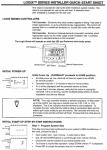
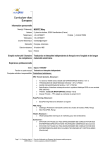
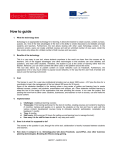
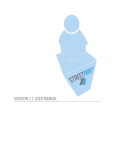
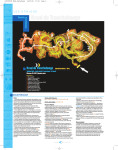

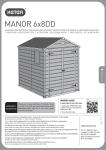
![mm [mm [1 um um [11115151116 |])|]1]](http://vs1.manualzilla.com/store/data/005839409_1-1dd2adaaab9a040f039445848c9c3135-150x150.png)
